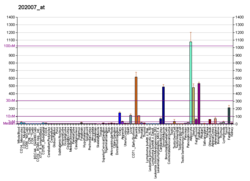NID1
Nidogen-1
Protein-coding gene in the species Homo sapiens
Nidogen-1 (NID-1), formerly known as entactin, is a protein that in humans is encoded by the NID1 gene.[5][6] Both nidogen-1 and nidogen-2 are essential components of the basement membrane alongside other components such as type IV collagen, proteoglycans (heparan sulfate and glycosaminoglycans), laminin[7] and fibronectin.[8]
| NID1 | |||||||||||||||||||||||||||||||||||||||||||||||||||
|---|---|---|---|---|---|---|---|---|---|---|---|---|---|---|---|---|---|---|---|---|---|---|---|---|---|---|---|---|---|---|---|---|---|---|---|---|---|---|---|---|---|---|---|---|---|---|---|---|---|---|---|
 | |||||||||||||||||||||||||||||||||||||||||||||||||||
| |||||||||||||||||||||||||||||||||||||||||||||||||||
| Identifiers | |||||||||||||||||||||||||||||||||||||||||||||||||||
| Aliases | NID1, NID, nidogen 1, entactin | ||||||||||||||||||||||||||||||||||||||||||||||||||
| External IDs | OMIM: 131390; MGI: 97342; HomoloGene: 1878; GeneCards: NID1; OMA:NID1 - orthologs | ||||||||||||||||||||||||||||||||||||||||||||||||||
| |||||||||||||||||||||||||||||||||||||||||||||||||||
| |||||||||||||||||||||||||||||||||||||||||||||||||||
| |||||||||||||||||||||||||||||||||||||||||||||||||||
| |||||||||||||||||||||||||||||||||||||||||||||||||||
| |||||||||||||||||||||||||||||||||||||||||||||||||||
| Wikidata | |||||||||||||||||||||||||||||||||||||||||||||||||||
| |||||||||||||||||||||||||||||||||||||||||||||||||||
Nidogen-1 is a member of the nidogen family of basement membrane glycoproteins. The protein interacts with several other components of basement membranes. Structurally it (along with perlecan) connects the networks formed by collagens and laminins to each other.[9] It may also play a role in cell interactions with the extracellular matrix.[10][11]
Mutations in NID1 cause autosomal dominant Dandy–Walker malformation with occipital encephalocele (ADDWOC).[12][13]
Nidogen-1 has been shown to interact with FBLN1.[14][15][16]
- "Human PubMed Reference:". National Center for Biotechnology Information, U.S. National Library of Medicine.
- "Mouse PubMed Reference:". National Center for Biotechnology Information, U.S. National Library of Medicine.
- Zimmermann K, Hoischen S, Hafner M, Nischt R (May 1995). "Genomic sequences and structural organization of the human nidogen gene (NID)". Genomics. 27 (2): 245–50. doi:10.1006/geno.1995.1038. PMID 7557988.
- Smith J, Ockleford CD (January 1994). "Laser scanning confocal examination and comparison of nidogen (entactin) with laminin in term human amniochorion". Placenta. 15 (1): 95–106. doi:10.1016/S0143-4004(05)80240-1. PMID 8208674.
- Ockleford CD, Bright N, Hubbard A, D'Lacey C, Smith J, Gardiner L, Sheikh T, Albentosa M, Turtle K (October 1993). "Micro-Trabeculae, Macro-Plaques or Mini-Basement Membranes in Human Term Fetal Membranes?". Phil. Trans. R. Soc. Lond. B. 342 (1300): 121–136. doi:10.1098/rstb.1993.0142. PMID 7904354.
- Yurchenco PD, Patton BL (2009). "Developmental and pathogenic mechanisms of basement membrane assembly". Curr. Pharm. Des. 15 (12): 1277–94. doi:10.2174/138161209787846766. PMC 2978668. PMID 19355968.
- Yi XY, Wayner EA, Kim Y, Fish AJ (March 1998). "Adhesion of cultured human kidney mesangial cells to native entactin: role of integrin receptors". Cell Adhes. Commun. 5 (3): 237–48. doi:10.3109/15419069809040294. PMID 9686320.
- "OMIM Entry - % 609222 - DANDY-WALKER MALFORMATION WITH OCCIPITAL CEPHALOCELE, AUTOSOMAL DOMINANT; ADDWOC". www.omim.org. Retrieved 2020-01-06.
- McNiven, Vanda; Ito, Yoko A.; Hartley, Taila; Kernohan, Kristin; Miller, Elka; Care4Rare Canada; Armour, Christine M. (May 2019). "NID1 variant associated with occipital cephaloceles in a family expressing a spectrum of phenotypes". American Journal of Medical Genetics. Part A. 179 (5): 837–841. doi:10.1002/ajmg.a.61095. ISSN 1552-4833. PMID 30773799. S2CID 73507129.
{{cite journal}}: CS1 maint: numeric names: authors list (link) - Adam S, Göhring W, Wiedemann H, Chu ML, Timpl R, Kostka G (September 1997). "Binding of fibulin-1 to nidogen depends on its C-terminal globular domain and a specific array of calcium-binding epidermal growth factor-like (EG) modules". J. Mol. Biol. 272 (2): 226–36. doi:10.1006/jmbi.1997.1244. PMID 9299350.
- Tran H, VanDusen WJ, Argraves WS (September 1997). "The self-association and fibronectin-binding sites of fibulin-1 map to calcium-binding epidermal growth factor-like domains". J. Biol. Chem. 272 (36): 22600–6. doi:10.1074/jbc.272.36.22600. PMID 9278415.
- Pan TC, Kluge M, Zhang RZ, Mayer U, Timpl R, Chu ML (August 1993). "Sequence of extracellular mouse protein BM-90/fibulin and its calcium-dependent binding to other basement-membrane ligands". Eur. J. Biochem. 215 (3): 733–40. doi:10.1111/j.1432-1033.1993.tb18086.x. PMID 8354280.
- Chung AE, Durkin ME (1990). "Entactin: structure and function". Am. J. Respir. Cell Mol. Biol. 3 (4): 275–82. doi:10.1165/ajrcmb/3.4.275. PMID 2119632.
- Yurchenco PD, Schittny JC (1990). "Molecular architecture of basement membranes". FASEB J. 4 (6): 1577–90. doi:10.1096/fasebj.4.6.2180767. PMID 2180767. S2CID 18724722.





